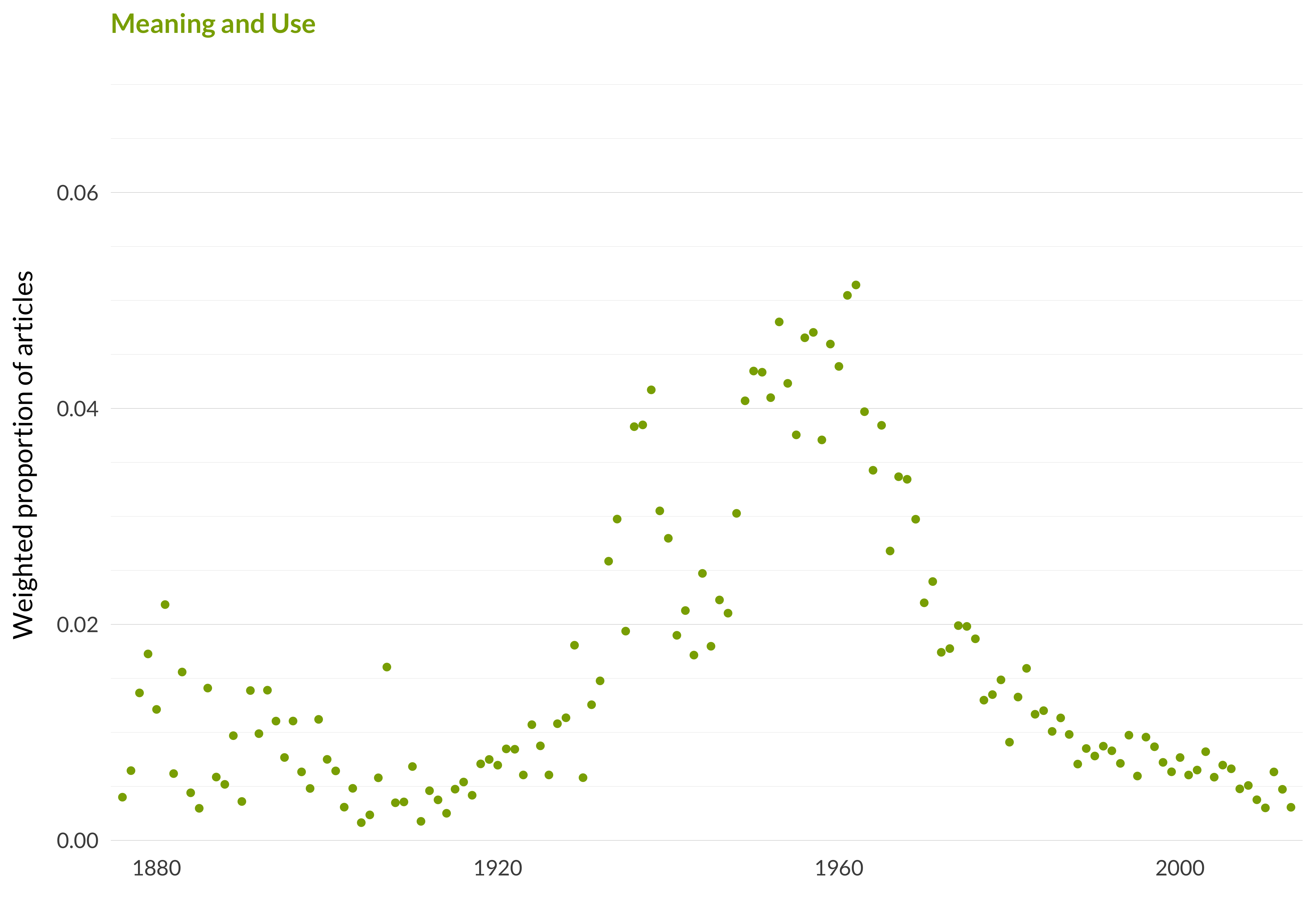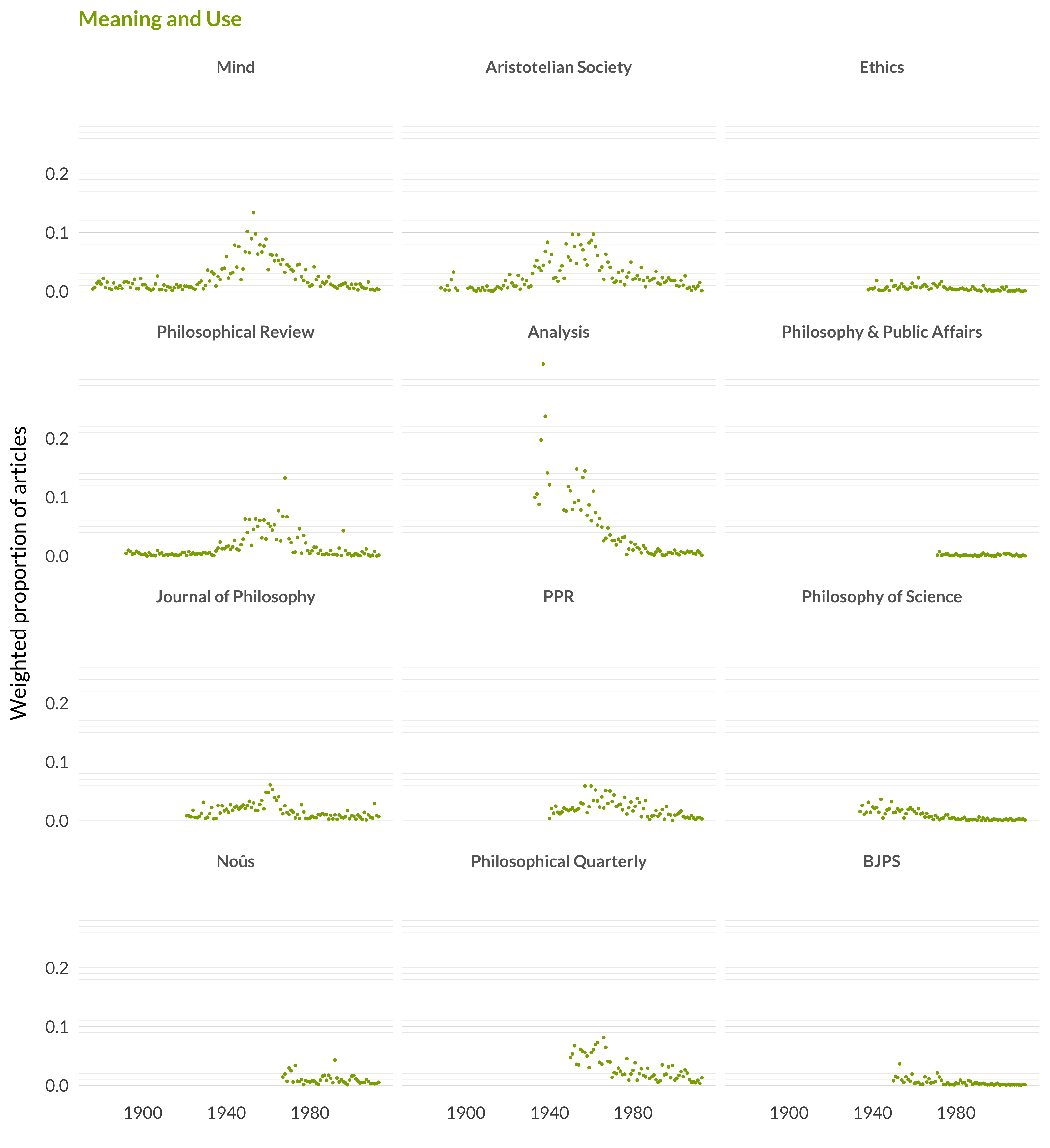2.22 Meaning and Use
Category: Philosophy of Language
Keywords: wittgenstein, ryle, word, usage, words, talking, signs, verbal, language, expressions, sign, moore, uses, grammatical, remark
Number of Articles: 632
Percentage of Total: 2%
Rank: 4th
Weighted Number of Articles: 598.3
Percentage of Total: 1.9%
Rank: 6th
Mean Publication Year: 1961.2
Weighted Mean Publication Year: 1962
Median Publication Year: 1961
Modal Publication Year: 1961
Topic with Most Overlap: Ordinary Language (0.0783)
Topic this Overlaps Most With: Definitions (0.0442)
Topic with Least Overlap: Quantum Physics (0.00027)
Topic this Overlaps Least With: Thermodynamics (0.00108)

Figure 2.56: Meaning and use.

Figure 2.57: Meaning and use articles in each journal.
Comments
This topic is mid-century philosophy of language, especially influenced by Wittgenstein’s later work. It’s tempting to say that it’s influenced by Philosophical Investigations, though as you can see some of this work takes place well before the Investigations are published. Still, a lot of this work turns out to have had a Wittgensteinian influence.
For example, those high points in the graph for pre-war Analysis are largely driven by a few exchanges. One of those is between Margaret MacDonald, A. M. MacIver on how to understand the type/token distinction. The exchange includes at least the following. (I think this is complete, though I may have missed some.)
- Language and Reference, by Margaret MacDonald, Analysis, 4 (2/3): 33–41 (1936).
- Token, Type and Meaning, by A. M. MacIver, Analysis 4 (4):58 - 64 (1936).
- Reply to Mr. MacIver, by Margaret MacDonald Analysis 4 (5):77 - 80 (1937).
- Rejoinder to Miss MacDonald, by A. M. MacIver, Analysis 4 (6):81 - 88 (1937).
- Further Reply to Mr. MacIver, by Margaret MacDonald, Analysis 5 (1):12 - 16 (1937).
- Last Words to Miss MacDonald, by A. M. MacIver, Analysis 5 (2):28 - 31 (1937).
- Erratum: Last Words to Miss MacDonald, by A. M. MacIver, Analysis 5 (3/4):64 (1938).
I don’t know how I ultimately want to feel about this exchange. On the one hand, I’m on MacIver’s side of the philosophical dispute at the heart of the exchange. On the other hand, you could put McIver’s articles in a museum as an exemplar of mansplaining.
MacDonald is notable for several reasons, this exchange not really being one of them. She was one of the founders of Analysis, and then edited it from 1948 until her tragically early death in 1956. She wrote a very important paper on natural rights; it is the only highly cited paper back in Topic 3. And it was her notes, along with those of Alice Ambrose, that got turned into Wittgenstein’s Lectures on Ethics. So there is a Wittgensteinian influence to these pre-war papers too.
I was surprised that this topic didn’t feature more papers in Philosophical Review. I thought Norman Malcolm’s move to Cornell in 1947 would have led to more Wittgensteinian articles here. But most of the Wittgenstein/Malcolm influenced work that turned up in the Review was in Topic 24.